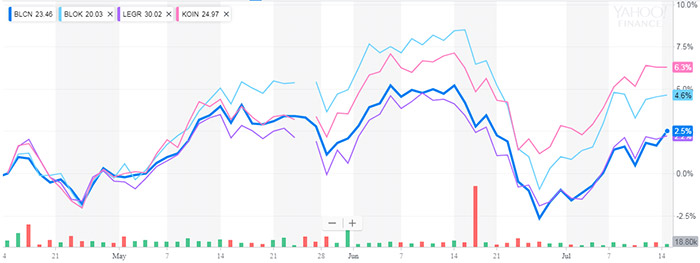“Want to hear something neat? My portfolio is up 24% this year.”
I watched my parents’ eyes pop after I spoke. You know, the “deer in the headlights” doom stare. Gotta say: not the reaction I was expecting.
We were at dinner and, as a developed favorite pastime, my parents were drilling me about the market.
My mom answered first: “Oh … my portfolio is up 5%.”
Yikes.
It seems they were letting their 401(k)s do all the work, and they were stuck in slow-growth funds that were barely matching the market’s rise this year.
Why was I doing almost five times better? Well, my main takeaway is this: I’m keeping an eye on disruptive tech trends.
As I mentioned on Saturday, one of those trends is blockchain technology. Experts project the industry will soar 77,400% as it explodes from a $4 billion market to a $3.1 trillion one. That’s something any investor would want to be a part of.
But investing in a new industry can be scary. Where do you start?
Well, I’ll tell you what I told my parents: Use an exchange-traded fund (ETF). That’s how you can easily start gaining broad, diverse exposure to the industry right as it booms.
Right now, there are a handful of ETFs that just hit the market. In late January, four blockchain ETFs launched in quick succession:
- The Innovation Shares NextGen Protocol ETF (NYSE: KOIN): $7.7 million in assets.
- First Trust Indxx Innovative Transaction & Process ETF (Nasdaq: LEGR): $44.4 million.
- The Reality Shares Nasdaq NexGen Economy ETF (Nasdaq: BLCN): $115 million.
- The Amplify Transformational Data Sharing ETF (NYSE: BLOK): $167 million.
But one of these ETFs is a better bet than the others. Here’s their performance laid out over the last three months:

From a quick glance, you might think KOIN (up 6.3%) is more promising. But it’s not very liquid or able to give you broad exposure.
BLOK is a solid pick considering it’s actively managed, but it tilts toward large caps, which makes it a less-effective blockchain play.
The one you want to pay attention to is BLCN (the bold blue line). It’s a purer, short-term play on blockchain — and, as of today, it crossed above its 50-day moving average, an important trend line.
Just know that blockchain ETFs have an expense ratio of 0.65% to 0.70% a year — or about $6.50 for every $1,000 invested. That’s a bit pricy for an ETF, and about the same as an actively managed mutual fund.
So if you’re looking for a more direct play, I’d suggest getting in on the stocks with the best chance of skyrocketing during the coming boom. To learn how, just click here.
Regards,

Jessica Cohn-Kleinberg
Managing Editor, Banyan Hill Publishing




